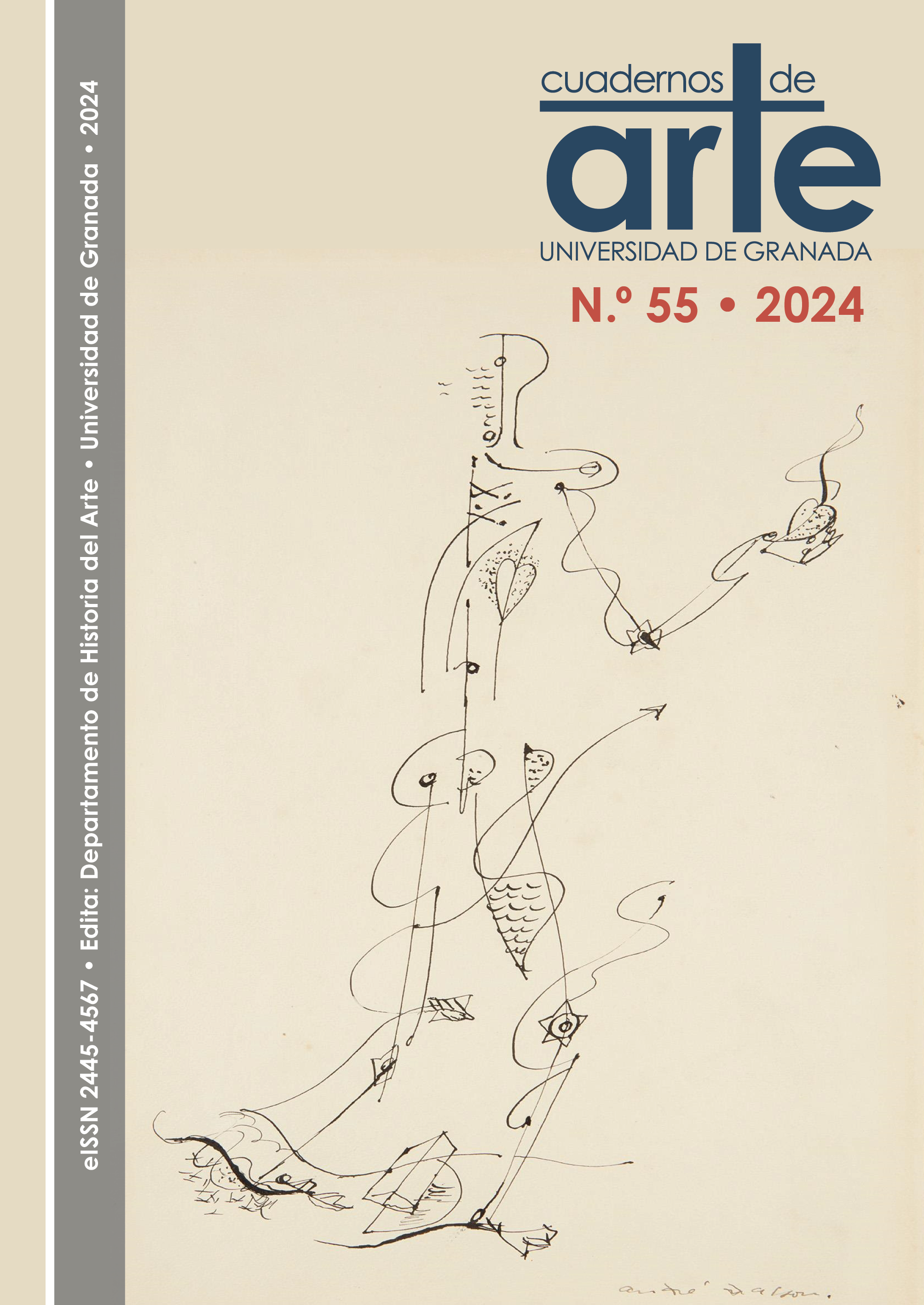Iconography of Pillage and Captivity in R. Monvoisin: Andromache as an Intertext
DOI:
https://doi.org/10.30827/caug.v55i0.29771Keywords:
Monvoisin, Elisa Bravo's Legend, Andromache, Disasters of war, Interdisciplinarity, Painting, Chile, Paris (France), 19th CenturyAbstract
Two paintings devoted to two moments in the life of a young woman in Chile, her abduction after a dramatic shipwreck and her subsequent captivity, make the French painter Raymond Auguste Monvoisin a graphic chronicler of the tensions existing in the country between whites and Mapuches in the mid-19th century. The interpretations of the two paintings focus not only on the national factor (the underlying confrontation), but also on other thematic and pictorial keys, such as the sexuality inherent in the abduction of women and the aesthetic treatment of the figure of the woman by the Orientalist movement. Furthermore, comparative interpretations emphasise the parallels that can be drawn between the protagonist and Helen of Troy and even Medea, in connection with another concomitant painting dedicated to the indigenous hero Caupolicán, i.e. in a fundamentally warlike context. However, Monvoisin’s treatment of the condition of women in war is actually shifted to more intimate aspects related to their children, whose intertextual reference point is the figure of Andromache, an important figure in French culture from the work of the playwright Jean Racine.
Downloads
References
Allamand, A. F. (2008). Raimundo Monvoisin, retratista neoclásico de la élite romántica. Santiago de Chile: Origo Ediciones.
Christo, M. de C. V. (2010a). Monvoisin no Salon de 1859: Índios, mestiçagem e pesimismo. En Encontro de História da Arte. Atas VI. Campinas-SP: IFCH/UNICAMP. Disponible en: https://doi.org/10.20396/eha.6.2010.3832 [Consultado el 4-11-2023].
Christo, M. de C. V. (2010b). Caupolican, Atahualpa, Aimbere e Cuauhtemoc: indios vencidos na pintura histórica Latino-Americana. Portuguese Studies Review (18), 2003-232.Disponible en: https://www.maproom44.com/psr/18_1.html[Consultado el 10-11-2023].
De la Maza, J. (2013). Del naufragio al cautiverio: Pintores europeos, mujeres chilenas e indios Mapuche a mediados del siglo XIX. Artelogie (5). Disponible en: https://doi.org/10.4000/artelogie.5208 [Consultado el 31-10-2023].
De la Maza, J. (2014). De obras maestras y mamarrachos. Notas para una historia del arte del siglo diecinueve chileno. Santiago de Chile: Metales Pesados.
Gallardo Porras, V. (2012). Rugendas, artista viajero y su aporte a la construcción de la representación indígena. Tiempo Histórico (4), 67-86. Disponible en: https://revistas.academia.cl/index.php/tiempohistorico/article/view/233 [Consultado el 8-11-2023].
Gónzalez, Y. (2016). Indias blancas tierra adentro. El cautiverio femenino en la Frontera de la Araucania, siglos XVIII y XIX. Anuario Colombiano de Historia Social y de la Cultura (43), 185-214. Disponible en: https://www.redalyc.org/articulo.oa?id=127146460007 [Consultado el 4-11-2023].
James, D. (1949). Movoisin. Buenos Aires: Emecé Editores.
Malosetti Costa, L. (1994). Rapto de cautivas blancas: un aspecto erótico de la barbarie en la plástica rioplatense del siglo XIX. En G. Curiel Méndez et al. (ed). Arte, historia e identidad en América: visiones comparativas. XVII Coloquio Internacional de Historia del Arte (pp. 297-314). México: Universidad Nacional Autónoma.
Muñoz Sougarret, J. (2010). El naufragio del Bergantín “Joven Daniel”, 1849. El indígena en el imaginario histórico de Chile. Tiempo Histórico (1), 133-148. Disponible en: [Consultado el 31-10-2023].
Pereira Salas, E. (1992). Estudios sobre la historia del arte en Chile Republicano. Santiago de Chile: Ediciones de la Universidad de Chile.
Ramírez Errázuriz, V. (2017). Ciencia y literatura. Eduard Poeppig y su representación dela Araucanía (siglo XIX). Cuadernos de Historia Cultural (6), 41-69. Disponible en: https://cuadernosdehistoriacultural.files.wordpress.com/2017/12/06-verc3b3nica-ramc3adrez-eduard-poeppig-vf.pdf[Consultado el 22-11-2023].
Romera, A. M. (1950). Monvoisin. En Razón y poesía de la pintura (pp. 97-122). Santiago de Chile: Ediciones Nuevo Extremo.
Vicuña Mackenna, B. (1884). Elisa Bravo, o sea, el misterio de su vida, de su cautividad y de su muerte, con las consecuencias políticas i públicas que la última tuvo para Chile, Santiago de Chile: Imprenta Victoria-H. Izquierdo.
Downloads
Published
How to Cite
Issue
Section
License
Los autores que publican en esta revista están de acuerdo con los siguientes términos:- Los autores conservan los derechos de autor y garantizan a la revista el derecho de ser la primera publicación del trabajo al igual que ser licenciado bajo una licencia Creative Commons que permite a otros compartir el trabajo con un reconocimiento de la autoría del trabajo y la cita de la fuente original, con un uso no comercial y siempre que no se hagan obras derivadas.
- Los autores pueden establecer por separado acuerdos adicionales para la distribución no exclusiva de la versión de la obra publicada en la revista (por ejemplo, situarlo en un repositorio institucional o publicarlo en un libro), con un reconocimiento de su publicación inicial en esta revista.
- Se permite y se anima a los autores a difundir sus trabajos electrónicamente (por ejemplo, en repositorios institucionales o en su propio sitio web) antes y durante el proceso de envío, ya que puede dar lugar a intercambios productivos, así como a una citación más temprana y mayor de los trabajos publicados (Véase The Effect of Open Access) (en inglés).






 ISSN-e: 2445-4567
ISSN-e: 2445-4567








